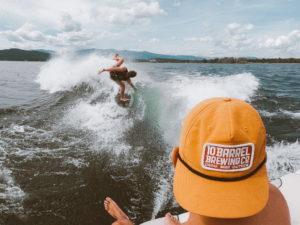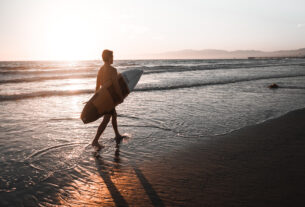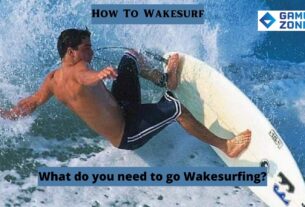What is Wakesurfing?
Wakesurfing is the act of standing on a surfboard and being towed by a motorboat, or wakeboard. Wakesurfing is all about balancing and taking turns as you ride the wakes of the boat. Wakesurfing is a relatively new sport that requires skill, agility, and guts.
It can be an overwhelming task to figure out how to do it right when you’re just starting. With the right setup and some helpful Wakesurfing tips, you can get on your feet in no time.
The best place to learn how to wake surf is in a controlled environment with someone who has experience teaching it. If you don’t have access to an instructor, there are plenty of online resources where you can find information and tutorials on the basics of the sport.
Steps are broken down in this article “Wakesurfing Tips” Read and learn…
getting started
If you want to try wake surfing, don’t worry! It’s easy and can provide a great workout. To get started, you’ll need a board and a boat to tow it. The board can be any size, but beginners often start out with a small one that’s easier to maneuver in the water.
Next, find your spot on the boat. You might want to sit just in front of the driver for balance and stability. Then put your arms behind you and lean back to start balancing on the wake. Then paddle out and jump up onto the wake when it starts coming toward you. Now that you’re wake surfing’, enjoy!

Top tips for the newbie surfer
If you’re a new surfer, there’s a lot to learn. And even seasoned surfers have to keep up with the latest trends and techniques.
To help you out, we’ve compiled a list of tips for the beginner wake surfer.
1) Don’t forget your gear! You’ll need a board, wetsuit, booties, and a leash to surf behind the boat.
2) Practice on flat water first! Before you take on the waves of the ocean or lake, find some calm water that looks like it has some waves – but isn’t too rough.
3) Get all your safety equipment together before you hit the water! Always wear your life jacket and check that everyone in your group is ready for action with their own life jacket and PFD (personal floatation device).
4) Have fun! Wakeboarding and wake surfing can be exhilarating activities and we hope these tips make it even more enjoyable
Boat Size and Weight Considerations
Boat size and weight are two big factors to consider when choosing a wakeboard. The bigger the boat, the more weight it can carry without sinking too low in the water. The reason is that heavier boats will have more ballast to balance out heavy loads.
If you’re worried about sinking too low in the water, but you have a small boat, you can always install a foam pool noodle on the side of your boat to help prevent it from sinking too low.
Choosing the right surfboard
Wakesurfing is a great way to get in on the action without investing in a boat and all of the gas and maintenance that goes with it. You can borrow or rent a board for an affordable price and enjoy the wake.
When choosing your board, you want to think about what type of water you’re going to be surfing in most often. If you’re mostly surfing lakes or smaller bays, then you’ll want a shorter, wider board that is more stable than one that is long and skinny.
Lake boards are usually around 5’7″-6’7″. The width will depend on your weight and how much power you plan to execute. Boards range from 20″ – 30″ wide with riders weighing 150 lbs+ going with boards on the wider size.
If you’re going to be surfing larger bodies of water like oceans, rivers, or large lakes then your board should be longer and thinner. The length will depend on how deep the body of water is where you surf most often. Ocean boards are typically around 7’0″ – 8’0″ while inland boards are around 5’7″ – 6’7″. These boards will flex more which helps when catching waves.
Safety tips for wake surfing
1. You’ll need a sturdy board.
2. When you’re grabbing the rope to get pulled, make sure you grab it with your hand in the back of your grip to keep yourself safe.
3. Set yourself up on the wake so that when you stand up, you’re not facing the boat head-on, but rather to the side. Doing this will help reduce injuries by protecting you from collisions with other people and objects in the water.
4. Keep an eye out for obstacles like docks or buoys in front of you so that you can avoid them while wake surfing.
5. Always wear a life jacket when wake surfing!
Keep the music low
If you’re wake surfing, you want to make sure that the music is not too loud. You’ll need to be able to hear what’s going on around you like other boats, bikers, and wake surfers. If your music is too loud, you won’t be able to hear these dangers coming and this could put your safety in danger. So keep the volume low when you’re out there!
Keep distance from the shore
We all know that the shoreline is a bad place to be. So, for safety reasons, you need to keep a distance from it. The first rule of wake surfing is to stay as far away from the shoreline as possible. If you have any doubt about your proximity to the shoreline, move. You’ll want to maintain at least 100 feet from the edge of the surf and follow the advice of any lifeguard on duty.
Get the right gear
Wakesurfing is a sport that requires you to be on the water. So, naturally, gear is important. You’ll need a board and a rope so you can attach yourself to the boat and not get pulled under. A board should be about 4-6 inches thick and be stable enough to hold your weight (which will change depending on what size you are).
Some boards come with fins and some don’t. The type of board you choose should depend on how much weight you need to carry and your skill level. If there are no fins, you’ll want to purchase these separately as well. You’ll also need a leash or leg rope to attach yourself to the boat. Generally, it’s best if the rope is at least 10 feet long (so it doesn’t tangle with the wake) and not too thin or thick.
Practice wake surfing
Wakesurfing with someone else can be a lot of fun, but it’s important to know what you’re doing. If you don’t, you could end up in the water at any moment. The first step is to practice wake surfing with a friend or family member who is experienced at it and ask them for guidance before heading out on your own. Once you get the hang of it, try going out by yourself. But make sure you find a spot where there are no obstacles in the way and always wear a life jacket to avoid any accidents!





